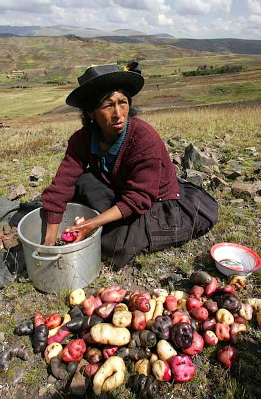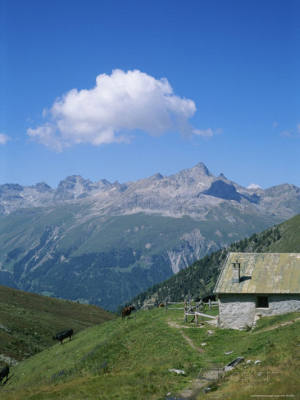
How traditional societies evened out food supplies
 Modern-day
homesteaders try to grow a lot of our own food, but we know we can
always head to the grocery store if a crop fails. Most members of
traditional societies, though, would be faced with starvation if they
didn't find ways to hedge their bets. Diamond
presented a slew of methods these traditional hunter-gatherers and
farmers used to ensure they always had food to eat, and some of these
techniques could be mimicked by modern homesteaders.
Modern-day
homesteaders try to grow a lot of our own food, but we know we can
always head to the grocery store if a crop fails. Most members of
traditional societies, though, would be faced with starvation if they
didn't find ways to hedge their bets. Diamond
presented a slew of methods these traditional hunter-gatherers and
farmers used to ensure they always had food to eat, and some of these
techniques could be mimicked by modern homesteaders.
My favorite example came from the Peruvian Andes, where farmers scattered small
garden plots across several
miles. Each farmer owned an average of 17 fields, each about 250
square feet in size, so the farmers were gardening a tenth of an acre
spread across many tiny
plots. To modern farmers, this method seems very inefficient
because the Peruvian farmers spent a lot of their time walking back and
forth between these little plots. However, even though the
traditional farmers produced lower average yields than they would if
they'd just made one big garden, the many plots in different areas
evened out variations in yield due to weather. As a result,
farmers always managed to grow enough to survive and were never faced
with starvation even during bad years.
 A similar technique involves moving seasonally. For example, farmers
in
the Alps gather together in the valleys for the winter then
disperse across the mountaintops during the spring and summer. On
the homestead scale, I'd love to one day have an orchard on a ridge top
that's more likely to miss late spring frosts.
A similar technique involves moving seasonally. For example, farmers
in
the Alps gather together in the valleys for the winter then
disperse across the mountaintops during the spring and summer. On
the homestead scale, I'd love to one day have an orchard on a ridge top
that's more likely to miss late spring frosts.
Other methods that traditional societies use to deal with unpredictable
food sources are less relevant to the modern homesteader. We
probably don't want to share all of our food with neighbors to even out
the supply (especially because we can now just dry, freeze, or can
excess for later). Gorging ourselves in the summer so we can live
off body fat during lean times probably won't go into fashion in America
anytime soon, either. But many homesteaders do use the
traditional method of "storing" excess produce by feeding it to livestock, then eating the pigs or other animals in the fall or winter.
Yet another
response to seasonal food shortages is to expand your diet. When
times are hard, people are willing to eat foods that aren't as tasty or
that need special processing to leach out poisons (such as tannin-rich
acorns). Modern homesteaders take a step in this direction when
they learn to love winter kale instead of craving hydroponic tomatoes
during the cold season.
Stay tuned for more lessons we can learn from traditional societies in tomorrow's post.
| This post is part of our The World Until Yesterday lunchtime series.
Read all of the entries: |
Want more in-depth information? Browse through our books.
Or explore more posts by date or by subject.
About us: Anna Hess and Mark Hamilton spent over a decade living self-sufficiently in the mountains of Virginia before moving north to start over from scratch in the foothills of Ohio. They've experimented with permaculture, no-till gardening, trailersteading, home-based microbusinesses and much more, writing about their adventures in both blogs and books.
Want to be notified when new comments are posted on this page? Click on the RSS button after you add a comment to subscribe to the comment feed, or simply check the box beside "email replies to me" while writing your comment.

Hi Anna and Mark,
So I have this idea of putting whatever into a 5 gallon bucket. Walking out into the forest somewhere, planting whatever and returning to harvest it?
Nothing special grown, just food for the winter. Maybe it might sometimes grow a 2nd year or even establish itself.
So my question for our other readers: What is in the bucket? What crops make sense. Can you grow anything in a forest or field for that matter in this way?
Maybe you just embed the bucket in the forest floor?
I had some tomatoes grow pretty well one year in a 5 gallon bucket. Their roots went out the bottom holes into the soil below.
John
John --- Around here, the deer would eat everything. Plus, your portable gardens would be in the shade, so you couldn't grow crops like tomatoes and squash; just things like leafy greens. You'd probably be better off making a real garden plot (fenced) somewhere else if you want to hedge your bets.
Of course, your deer pressure might not be as heavy as ours....
The Peruvians with multiple small plots are practicing a variation of the "don't put all your eggs in one basket" concept. Pretty smart. Sharing food is a matter of bartering with a long, term outlook. You help Neighbor Sam whose crop was poor this year and maybe next year yours will be bad and Sam can pay you back. Sharing on the community level is a whole lot different than having a central govt steal your food to redistribute it to someone two thousand miles away and will never pay you back. Our society is too big and dehumanized.
And those Peruvians have nothing better to do than walk miles between fields anyways: they don't get The Jerry Springer Show down there.